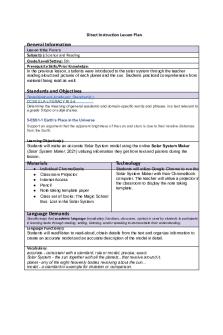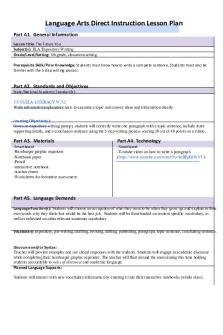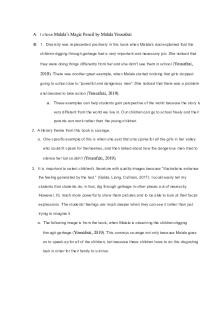Lesson Plan / task PDF

| Title | Lesson Plan / task |
|---|---|
| Course | Instructional Planning and Presentation |
| Institution | Western Governors University |
| Pages | 7 |
| File Size | 229.2 KB |
| File Type | |
| Total Downloads | 72 |
| Total Views | 143 |
Summary
lesson plan for performance assessment...
Description
Direct Instruction Lesson Plan Template
General Information Lesson Title: Plant Survival Subject(s): Life Science Grade/Level/Setting: 3rd Grade Instructional Setting: Class comprised of a variety of students with different abilities and backgrounds: • 28 students total (16 boys and 12 girls) • 19 students are on-grade-level readers • 5 students are two grades above reading level (2 are identified as gifted and talented) • 2 students are English learners at the intermediate level • 2 students who are identified as having special needs *Students will be seated in groups of two, and placed in rows facing the front of the classroom for easy viewing of the white board.
Prerequisite Skills/Prior Knowledge: ●
Students are comfortable using their chromebooks, operating Kahoot, and conducting efficient collaborative work.
●
Students are able to Identify the parts of a plant such as seeds, roots, stems, leaves, flowers, and fruits and are familiar with their primary functions.
Standards and Objectives State/National Academic Standard(s): 3.LS.2 Plan and conduct an investigation to determine the basic needs of plants to grow, develop, and reproduce. https://www.doe.in.gov/standards/science-computer-science
Learning Objective(s): Given a quiz, students will be able to identify and apply the needed items and conditions for plant growth and survival with 80% accuracy.
Materials
Technology
●
dead plant
●
plant growth song - internet
●
chromebook
●
plant growth video - internet
●
whiteboard
●
●
paper and pencil
Chromebooks used to support student learning within group work and to redefine the individual investigation of plant growth and manipulation.
●
smartboard
●
online activity allows for redefinition and modification of students ability to experiment
●
graphic organizer
●
personalized research worksheet
●
individualized group reference sheet
●
experiment chart / worksheet
●
interactive online quiz - Kahoot
Language Demands Specific ways that academic language (vocabulary, functions, discourse, syntax) is used by students to participate in learning tasks through reading, writing, listening, and/or speaking to demonstrate their understanding.
Language Function(s): ●
Students will identify that plants need specific things to grow: light, air, water, nutrients, and space.
●
Students will analyze plant health by experimenting and manipulating different living conditions using an interactive learning activity.
●
Students will research and explain the 5 needs of plant growth.
Vocabulary: Light, soil, nutrients, water, air, oxygen, CO2, photosynthesis, respiration, growth, acronym
Discourse and/or Syntax: Discourse: In class, pairs, and small groups, students will discuss, analyze, and investigate the things necessary for plant survival. Syntax: The students will use an experiment chart, several graphic organisers and sentence frames to organize their learning throughout the lesson.
Planned Language Supports: Students will be provided a graphic organizer displaying sections to fill out each letter in the acronym L.A.W.N.S., and participate in collaborative learning. They will also be given a personalized research worksheet, an individualized group reference sheet, and experiment chart / worksheet to fill out during investigations. Writing prompts will also be available during journaling to assist in paragraph structure and organization.
Instructional Strategies and Learning Tasks
Anticipatory Set: Activity Description/Teacher Teacher will present students with a dead plant to observe and ask “why did this plant die?” ●
Activating prior knowledge by requesting students answer this question in a think pair share (active participation strategy: think pair share) with their neighbor and
Student Actions Students will observe the dead plant then write down their ideas explaining “What happened to the plant and why?” then discuss with their neighbor and then with the teacher and class.
then with their teacher and class.
Presentation Procedures for New Information and/or Modeling: Activity Description/Teacher
Student Actions
Discuss thoughts from think pair share activity as a class. ●
●
Teacher will lead the discussion and write the students' responses on the white board. From these responses, the teacher will guide students to identify what plants need in order to survive; light, air, water, nutrients, and space to grow.
●
● ● ●
The teacher will then stimulate students' minds by listening to a song about the 5 things plants need to grow.
The teacher introduces the acronym L.A.W.N.S. and writes the letters vertically on the white board while providing students with a graphic organizer to teach vocab. ●
The teacher will lead students to take notes while they, as a class, describe, and define each need, and how it relates to plant growth.
●
The teacher shows a plant growth video that corresponds with the graphic organizer.
●
After the video the teacher will facilitate a class discussion using discussion questions to review the graphic organizer
●
Students will review possible causes of death and participate in a whole group discussion on the essentials that contribute to plant growth and survival. Learn new vocab Listen to The Needs of a Plant song for kids YouTube. Using a graphic organizer students will be learning about the needs of plants using the acronym L.A.W.N.S. during direct instruction, and taking notes while watching THE GENERATION GENIUS PLANT GROWTH CONDITIONS VIDEO. Students will participate in a class discussion to review the video content and graphic organizer.
Guided Practice: Activity Description/Teacher The teacher will divide students into 5 groups. Each cooperative learning group (Grouping strategy: Cooperative learning group) will be assigned a plant “need” to investigate (i.e. light or space). Each group will have their own reference sheet of videos and articles and be provided with a personalized worksheet with a specific set of questions to answer. ●
Within the groups students will each be assigned a specific role (i.e. leader or
Student Actions ●
Students will work in cooperative and predetermined learning groups to research one of the plants’ survival needs.
●
Students will be responsible for fulfilling their individual role within the group as well as complete their personalized worksheet.
●
Students will participate in a class presentation
recorder). ●
When finished, each group will present their findings to the rest of the class.
●
As students are working, the teacher will circulate the room observing each group and asking guiding questions to enhance student learning.
Independent Student Practice: Activity Description/Teacher Teachers will have students work independently using an interactive science activity (technology strategy: online game) on how plants grow. ●
●
Provide a worksheet with probing questions asking the students to experiment with positive and negative conditions ( i.e. too much water, not enough light) and record the outcomes.
Student Actions ●
Students will conduct online experiments to determine what plants require for successful growth. They will be able to manipulate things, such as sunlight and water, to attempt to grow a successful plant.
●
Following the worksheet and completing the chart, students will be able to investigate and attempt to keep the plant healthy and growing.
During the students independent work, the teacher will assess student progress, ask analytical questions, and be available to assist and clarify when needed.
Culminating or Closing Procedure/Activity: Activity Description/Teacher To wrap up the lesson the teacher will have students reflect on the days’ lesson in their journals. ●
The teacher will write sentence frames on the whiteboard for students to reference.
●
The teacher can use this to evaluate student learning.
The teacher will have students play Kahoot (online quiz game) as a final class review of material. ●
This will include a vocab review
The teacher will give the students a summative assessment (assessment strategy: quiz) to check for student understanding. ●
it will cover all five of the plants needs, lesson vocab, and experiment outcomes.
Student Actions ●
Students will write an information paragraph about what they have learned about plant health , growth and survival.
●
Students will use their own devices to answer the Kahoot questions that appear on the smart board.
●
Students will take a quiz to demonstrate understanding of the lesson material.
Differentiated Instruction Consider how to accommodate for the needs of each type of student. Be sure that you provide content specific accommodations that help to meet a variety of learning needs.
Gifted and Talented: ●
The journal entry is open ended, allowing for an individually appropriate response.
●
Extended learning available during research.
●
Students will be asked different and higher level questions of cause and effect during guided practice. For example: Ask how each individual plants’ needs will affect its life and why it is an essential part of growth; What will happen to the plant without sunlight and why? This analysis of content will extend thinking to cell function and into the next lesson: photosynthesis.
●
Individualized worksheets provided during independent interactive experiments will offer a larger variety and more detailed experimental analysis and questioning and resource material handout will include higher reading level articles and reference materials.
●
Specific seating and pairing of academically strong students to support understanding during paired activities. Introduced to vocab prior to lesson and provided a vocab list with pictures as a reference during the lesson. Visual supports on graphic organizers and worksheets. Extended and personalized sentence frames to guide their paragraph during journaling. Frequent teacher check ins and additional clarification when needed.
EL:
● ● ● ●
Students with Other Special Needs: learning disabilities ●
Allow an oral description of what was learned during the lesson rather than a journal entry.
●
Strategic grouping during multiple collaborative activities to allow for peer assistance and support.
●
Tracking student performance throughout the lesson and supplying one on one coaching when needed, as well as providing frequent feedback to help them monitor their progress and reflect on their work.
●
Highlighted text on worksheets and graphic organizers to direct attention to main ideas, key words, directions, and overall important information.
Assessment Formative: ●
Teacher will monitor student thinking and learning by observing students during group and independent work, recording responses during oral presentations, and analyzing individual results from the interactive Kahoot quiz.
●
Teacher will support and extend student thinking and learning by questioning and quideing student comments and answers during class discussions and one-on-one interactions, checking over investigation worksheets and charts, and reviewing journal entries.
Summative:
Given a quiz, students will be able to identify and apply the needed conditions for plant growth and survival with 80% accuracy.
Part B Active Participation Strategy: I chose to implement an active participation strategy to start the lesson on plant survival. During the anticipatory set students participated in a think pair share activity with their neighbor. I chose to incorporate this particular strategy so students have an opportunity to share their thoughts in a more relaxed setting before having to speak to the entire class. Research says that this strategy will improve speaking, listening, and social skills (Cowling, n.d.). According to former teacher Tania Cowling (n.d.), when students brainstorm in pairs, each student learns from their partner by expanding vocabulary and building on prior knowledge. Overall discussing with a partner helps focus attention, maximise participation, increases comprehension, and fosters engagement in the material (Cowling, n.d.).
Grouping Strategy: During guided practice students worked in cooperative learning groups to research the needs of plants. I chose this particular grouping strategy to foster interpersonal relationships and overall positive attitudes towards learning. Research shows that cooperative learning approaches produce higher academic achievement than strategies that require students to do similar tasks individually (Burden, 2013). These formal learning groups provide students support from their peers and the understanding that they are responsible for the learning of their team members as well as their own (Burden, 2013). Cooperative learning is ideal for creating a healthy and effective learning environment.
Technology Strategy: I decided to integrate a technology strategy into the instruction during independent student practice. The students used an interactive online game to experiment with plant survival and growth. I chose to use interactive technology to simulate a real-world experience and make the learning authentic. Students are able to manipulate and grow plants under a plethora of different conditions. To physically grow these plants would take an unrealistic amount of time to complete and be overall inefficient. Utilizing this type of technology allowed the teacher to ask probing questions, invoke higher level thinking, and differentiate learning. Research claims that software that promotes higher level thinking is beneficial to cognitive growth and independent learning, and is overall ideal for students with varying abilities (Kolb, 2018).
Assessment Strategy: I chose to wrap up the day's lesson with a summative assessment. At the end of the closing procedures the teacher will have the students take a comprehensive, teacher made quiz that will cover all five of the plants needs, lesson vocab, and the students experimental outcomes. They will be expected to be able to identify and apply the needed conditions for plant growth and survival with 80% accuracy. I chose this particular strategy to check for student
understanding and retention of the material, and to make sure students were reaching the learning objective. Since there were several different methods of formative assessments being implemented throughout the lesson, I believe that adding a criterion-referenced evaluation is necessary to provide a well rounded idea of the students individual mastery of the subject and overall success of the lesson. Research says that summative assessments support student motivation to pay attention, assist teachers to make instructional adjustments by identifying ineffective areas, and provide a basis for recording grades (Reddy, n.d.). The author also states that many schools consider this evaluation to successfully measure educator performance, implement teacher accountability, and be the dominant parameter in the grading system (Reddy, n.d.).
References: Burden, P. R., & Byrd, D. M. (2013). Methods for effective teaching: Meeting the needs of all students (6th ed.). Boston, MA: Allyn & Bacon. ISBN: 978-0132901703 Cowling, T. K. (n.d.). How to Use the Think-Pair-Share Activity in Your Classroom. Retrieved January 20, 2021, from https://www.wgu.edu/heyteach/article/how-think-pair-share-activity-can-improve-your-classroomdiscussions1704.html Kolb, L. (2018, September 28). Research-Based Tech Integration StrategiesLiz. Retrieved January 20, 2021, from https://www.edutopia.org/article/research-based-tech-integration-strategies Reddy, K. (n.d.). Summative Evaluation Advantages and Disadvantages. Retrieved January 21, 2021, from https://content.wisestep.com/advantages-disadvantages-summative-evaluation/...
Similar Free PDFs

Lesson Plan / task
- 7 Pages

Task 1 - Lesson Plan
- 6 Pages

Task 1 - Lesson Plan
- 8 Pages

Lesson Plan - - Task 2
- 7 Pages

Lesson Plan task 1
- 6 Pages

Geometry Task 2 Lesson Plan
- 7 Pages

BDM2 Task 1 lesson plan
- 15 Pages

Task 1 Math Tools lesson plan
- 13 Pages

HXM1 Task 1 pdf - lesson plan
- 5 Pages

JOT2 Task 2 Lesson Plan example
- 8 Pages

C732 Task 1 Lesson Plan - Passed
- 6 Pages

C365 Lesson Plan Task 1.docx
- 8 Pages
Popular Institutions
- Tinajero National High School - Annex
- Politeknik Caltex Riau
- Yokohama City University
- SGT University
- University of Al-Qadisiyah
- Divine Word College of Vigan
- Techniek College Rotterdam
- Universidade de Santiago
- Universiti Teknologi MARA Cawangan Johor Kampus Pasir Gudang
- Poltekkes Kemenkes Yogyakarta
- Baguio City National High School
- Colegio san marcos
- preparatoria uno
- Centro de Bachillerato Tecnológico Industrial y de Servicios No. 107
- Dalian Maritime University
- Quang Trung Secondary School
- Colegio Tecnológico en Informática
- Corporación Regional de Educación Superior
- Grupo CEDVA
- Dar Al Uloom University
- Centro de Estudios Preuniversitarios de la Universidad Nacional de Ingeniería
- 上智大学
- Aakash International School, Nuna Majara
- San Felipe Neri Catholic School
- Kang Chiao International School - New Taipei City
- Misamis Occidental National High School
- Institución Educativa Escuela Normal Juan Ladrilleros
- Kolehiyo ng Pantukan
- Batanes State College
- Instituto Continental
- Sekolah Menengah Kejuruan Kesehatan Kaltara (Tarakan)
- Colegio de La Inmaculada Concepcion - Cebu



